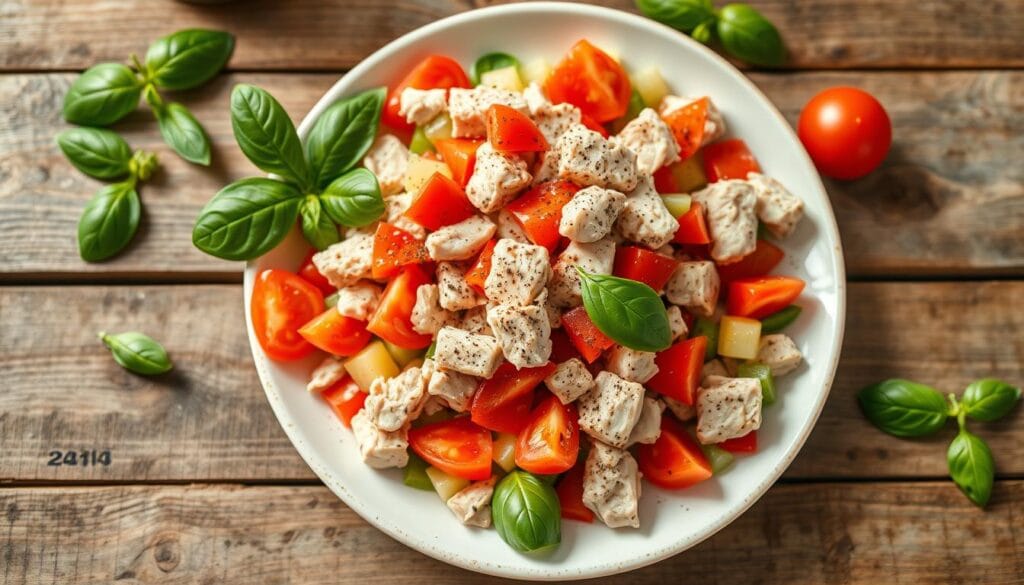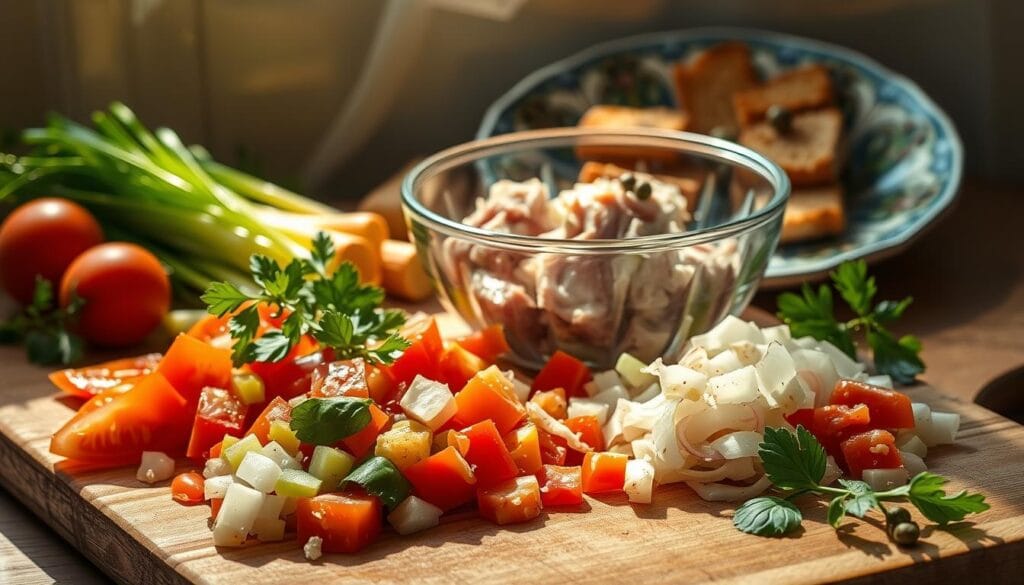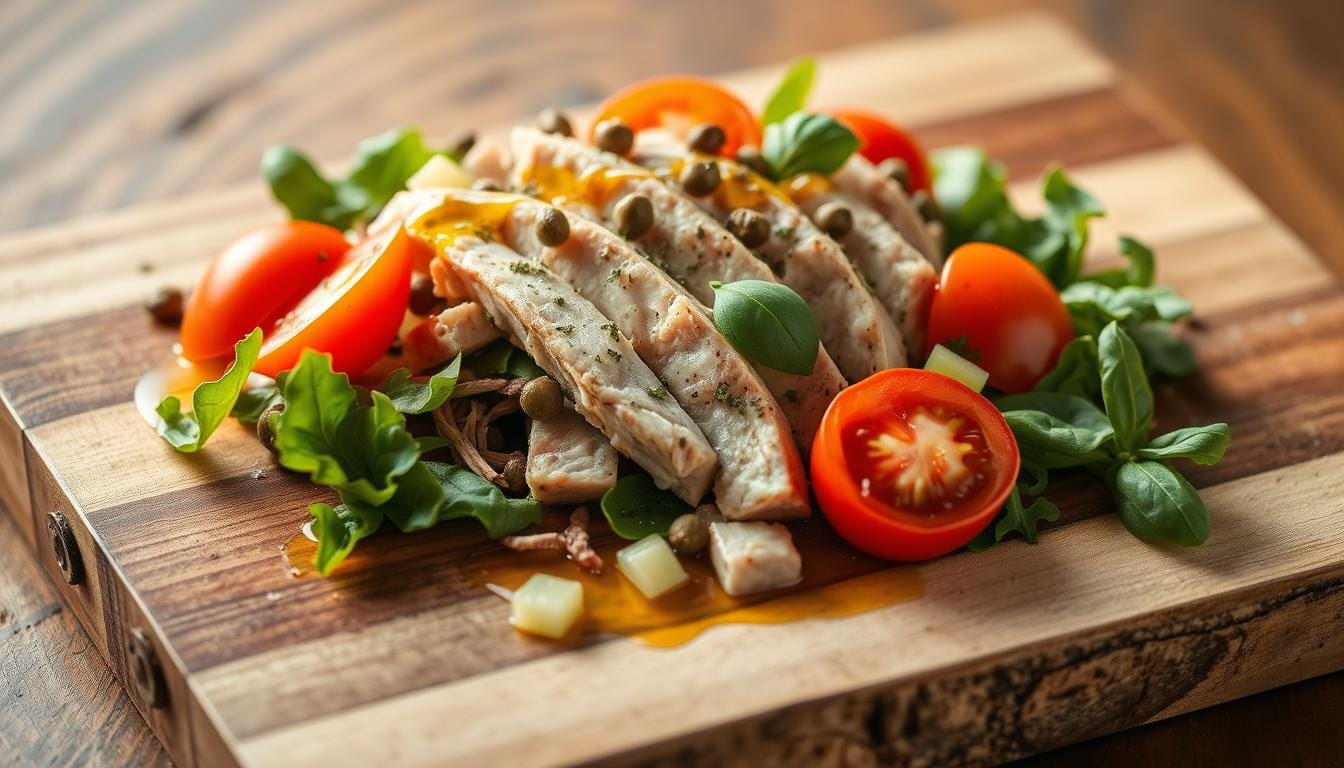How to Make the Best Italian-Style Tuna Salad for a Delicious and Flavorful Meal
Want to make tuna salad better than usual? Try the Italian way. It mixes Mediterranean tastes, top-notch ingredients, and old cooking methods. Instead of heavy mayonnaise, it uses olive oil and fresh herbs for a light yet fulfilling taste.

Quality tuna, crisp veggies, and scents like garlic and lemon are key. These steps turn simple tuna salad into a dish full of flavor. Learn how Italian cooking makes something simple into something fancy.
Key Takeaways
- Italian-style tuna salad uses olive oil instead of mayonnaise for a healthier, richer taste.
- Mediterranean ingredients like capers and basil elevate the flavor profile.
- Focus on fresh produce and high-quality canned tuna for the best tuna salad results.
- Balance of textures and acidity defines its distinct Italian character.
- Easy to prepare yet sophisticated enough for any occasion.
The Italian Secret to Elevated Tuna Salad

Italian tuna salad changes the game with fresh, bold flavors instead of heavy dressings. It lets ingredients shine while keeping things balanced. Let’s explore how tradition and skill make this dish stand out.
What Makes Italian Tuna Salad Different
- No mayonnaise—replaced with olive oil and citrus for brightness
- Simple components: tuna, vegetables, and herbs take center stage
- Focus on freshness over preservatives
The Mediterranean Influence on Flavor Profiles
| Classic Tuna Salad | Italian-Style |
|---|---|
| Mayonnaise-based | Olive oil and lemon juice |
| Blended textures | Crunchy vegetables like celery or bell peppers |
| Commercial herbs | Fresh basil or parsley for vibrancy |
Quality Ingredients: The Foundation of Italian Cooking
Italian recipes call for top-notch ingredients. Think oil-packed tuna, ripe tomatoes, and extra-virgin olive oil. These ensure every bite is true to its roots. Even small touches like capers or red onions add depth without making it complicated.
The Rich History of Tuna in Italian Cuisine
Looking into the history of tuna salad shows how old traditions shape its taste today. The ancient Romans used salt and brine to keep tuna fresh. This method helped fish reach far inland, becoming common in both coastal and inland areas.

In places like Sicily and Liguria, unique styles emerged. Sicily mixed tuna with capers and olives, while Liguria used fresh herbs and olive oil. These styles have evolved into today’s tuna salad recipes, each showing local tastes and traditions.
- Sicily: Uses preserved tuna with citrus and fennel.
- Liguria: Focuses on bright herbs and light dressings.
- Campania: Combines tuna with tomatoes and garlic.
Italian tuna salad differs from American versions by not using mayonnaise. Instead, it uses olive oil and citrus for a fresh taste. This method keeps the fish’s natural taste and texture, a key part of today’s recipes.
| Region | Signature Ingredients | Preservation Method |
|---|---|---|
| Sicily | Capers, olives, lemon | Salt curing |
| Liguria | Basil, garlic, olive oil | Brine storage |
| Calabria | Peperoncino, oregano | Sun-drying |
Knowing this history makes you value the tradition in every bite of your homemade tuna salad. From Roman times to your kitchen, history adds flavor to every ingredient.
Essential Ingredients for Authentic Italian Tuna Salad
Mastering the Italian approach starts with the right ingredients. These components turn your homemade tuna salad into a dish full of authentic flavor and freshness.
Selecting the Right Tuna: Oil-Packed vs. Water-Packed
Begin with tuna packed in olive oil. This type keeps the salad moist and rich. Water-packed tuna can make it dry. Choose albacore or yellowfin for a firm texture. Drain it well to avoid too much oil.
Fresh Produce Components That Make a Difference
Add these essentials for texture and nutrition:
- Celery for crispness
- Red onion (finely diced for subtle tang
- Kalamata olives for briny contrast
- Cherry tomatoes for natural sweetness
These ingredients make your healthy tuna salad vibrant and full of flavor.
The Importance of Quality Olive Oil
“A great salad needs an olive oil that sings,” says Naples-based chef Lucia Rossi. “Choose a certified extra virgin with grassy notes.”
Use the first cold press oil for the best aroma. Drizzle 1-2 tablespoons into your mix. This binds flavors without overpowering the tuna’s taste.
Herbs and Aromatics: The Italian Way
Mince fresh basil and parsley just before mixing. Add dried oregano sparingly—too much can overwhelm. Garlic (one clove finely minced) adds depth without a raw bite. Let herbs sit for 5 minutes after mixing to bloom flavors.
How Classic Tuna Salad Transforms with Italian Techniques
Traditional tuna salad with mayo uses creamy dressings. But, Italian methods change everything. They use olive oil and citrus instead, making fresh ingredients the main attraction.
| Traditional (Mayo-Based) | Italian (Olive Oil-Based) |
|---|---|
| Thick mayonnaise base | Zesty lemon and olive oil blend |
| Smooth, uniform texture | Textural contrast: flaky fish + crisp veggies |
| Single-layer of flavor | Layered herbs, briny accents, and acidity |
The No-Mayo Approach
- Swap mayo for 2 tablespoons extra-virgin olive oil per can of tuna
- Add lemon juice (1-2 tsp) to brighten fish without masking its flavor
- Incorporate capers or Kalamata olives for umami depth
Texture and Balance Principles
Italian recipes focus on different textures:
- Flaky tuna chunks retain their shape
- Cherry tomatoes add juicy bursts
- Grated carrots or celery sticks provide crunch
Layering Flavors Like an Italian Chef
- Marinate tuna in olive oil + lemon for 10-15 minutes before mixing
- Add parsley and basil last to preserve freshness
- Season with salt at the end to enhance all components
These methods make sure each bite is full of new tastes. Unlike tuna salad with mayo, which is often too uniform.
Step-by-Step Guide to Making Your Homemade Tuna Salad Italian-Style
Learn how to make a easy tuna salad recipe with bold flavors. Start by draining oil-packed tuna well. This keeps the salad from getting soggy. Then, pat the tuna flakes dry with a paper towel for a lighter texture.
- Chop fresh parsley, a handful of kalamata olives, and red onion into small dice. Mix these in a bowl with a drizzle of Pompeian extra virgin olive oil.
- Add flaked tuna and a squeeze of lemon juice. Toss gently—overmixing breaks the fish into mush.
- Season with cracked black pepper and a pinch of oregano. Taste and adjust acidity with another lemon wedge if needed.
- Let flavors meld for 15 minutes at room temperature before serving. This resting time enhances the simple tuna salad‘s depth without added complexity.
Serve chilled on toasted ciabatta or as a pasta topper. For a make-ahead option, prepare ingredients separately and combine just before eating to preserve crispness. Remember: less is more—this recipe’s strength lies in quality ingredients like Castelvetrano olives and premium tuna. Perfect for lunchboxes or dinner upgrades, this method proves authentic Italian techniques don’t require elaborate steps.
The Perfect Bread Pairings for Your Italian Tuna Salad Sandwich
Choosing the right bread can turn your Italian tuna salad into a memorable tuna salad sandwich. The perfect bread adds texture, balances flavors, and keeps each bite fresh. Let’s find out how to pick the best bread for your sandwich.
Ciabatta: The Traditional Choice
Ciabatta has an airy crumb and crispy crust. Its open texture stops it from getting soggy. This lets the tuna’s flavor stand out. Look for brands like La Brea Bakery or Rustic Crust for the best taste. Choose a medium-thick slice to avoid it crumbling.
Rustic Country Loaves and Other Options
Pane rustico is a dense loaf that keeps ingredients inside. Focaccia adds softness with herbs, while a French baguette’s crunch contrasts well. These choices let you pick based on your texture preference.
Toast or Fresh? It’s All About the Occasion
Toasting the bread helps keep it dry, perfect for packed lunches. For fresh eating, serve it un-toasted to enjoy its sweetness. A tip: place lettuce or parchment between the bread and filling to keep it crisp.
Creative Serving Ideas Beyond the Sandwich
Make your Italian tuna salad a star with these creative ideas. Turn simple meals into something special or wow your guests with new takes on this classic dish.
Stuffed Vegetables: A Mediterranean Tradition
Bring Mediterranean vibes by using veggies as bowls. Cut out the insides of tomatoes, bell peppers, or zucchini. Fill them with tuna salad and add capers or olive oil on top. These colorful dishes are perfect for summer or a quick lunch. Enjoy them at room temperature for the best taste.
Pasta Combinations That Shine
Pair tuna salad with pasta for a refreshing or filling meal. Here are some great matches:
- Cold pasta salad: Mix with penne and lemon zest for a tangy twist.
- Warm dishes: Place tuna salad on toasted farfalle or on top of baked pasta for a layered treat.
Elegant Appetizer Presentations for Entertaining
Make tuna salad a hit as an appetizer. Try these fancy options:
- Crostini: Spread on toasted baguette rounds with arugula for a peppery kick.
- Endive Leaves: Use crisp leaves as cups filled with tuna salad and a lemon wedge garnish.
- Puff Pastry: Stuff vol-au-vents with tuna salad and sprinkle with parsley for a small but satisfying treat.
Nutritional Benefits of This Healthy Tuna Salad Variation
Choosing the Italian-style healthy tuna salad means you care about your health and taste. This salad is packed with protein and has fewer calories than mayo-based ones. Tuna alone gives you 25-30 grams of lean protein, helping your muscles and keeping you full.
- Heart-healthy fats: Using olive oil instead of mayo adds good fats. These fats lower bad cholesterol and heart disease risk.
- Vitamins & minerals: Tomatoes, onions, and basil add vitamins C, potassium, and antioxidants.
- Low in saturated fats: Olive oil reduces saturated fats by 50% compared to mayo.
This healthy tuna salad avoids added sugars and preservatives found in store-bought versions. It follows Mediterranean dietary guidelines for balanced eating. Eating foods rich in olive oil and seafood can reduce inflammation and support brain health. Adding avocado or walnuts boosts omega-3s, making it great for fitness or meal prep.
Each bite of this Italian dish is full of nutrients and under 400 calories. It shows that healthy eating can be delicious.
Simple Tuna Salad Adaptations for Dietary Restrictions
Enjoy your Italian-inspired tuna salad without compromising dietary needs. These adjustments keep the Mediterranean flavors intact while meeting specific requirements.
| Dietary Need | Adjustment | Example |
|---|---|---|
| Gluten-Free | Swap breads | Use gluten-free ciabatta or lettuce wraps |
| Low-Carb | Reduce starches | Replace carrots with cucumber or zucchini |
| High-Protein | Add protein sources | Incorporate hard-boiled eggs or white beans |
Gluten-Free Options
Choose gluten-free breads like Schar Ciabatta or use collard greens as a wrap. Serve over romaine leaves for a no-carb option. Always verify ingredients to avoid cross-contamination.
Low-Carb Variations
Cut carbs by omitting bread entirely or using almond flour crackers. Replace starchy veggies with pickled onions or artichoke hearts. Try serving tuna salad over spinach for an extra leafy base.
Adding Protein for Athletic Needs
Boost protein by adding two boiled eggs or 1/4 cup cannellini beans. Mix in 2 oz grilled shrimp or a spoonful of feta for extra nutrients. Combine with a handful of arugula for freshness.
Pair these changes with quality olive oil and fresh herbs to preserve authentic flavors. Adjust portions based on goals—like doubling the tuna portion for increased protein intake.
Make-Ahead Tips and Proper Storage Techniques
Learning how to store your homemade tuna salad is key. It keeps it fresh and tasty. Follow these tips to enjoy it as much as the first time.
How Long Your Italian Tuna Salad Will Keep
The olive oil in this recipe makes it last longer than mayo-based ones. Keep it in the fridge for up to 3 days. Always refrigerate it within 2 hours of making.
Best Containers for Freshness
- Glass jars: They keep flavors in and odors out.
- BPA-free plastic: Stasher bags are airtight and light.
- Stainless steel containers: They stop tuna from drying out.
Reviving Day-Old Tuna Salad
Is it a bit dry? A bit of fresh olive oil and lemon juice can fix it. Just toss it gently. Let it sit at room temperature for 10–15 minutes before serving.
Want to impress at a party? Prepare ingredients ahead. Marinate tuna in olive oil for up to 24 hours. Mix herbs and veggies just before serving to keep them fresh.
Seasonal Adjustments to Your Easy Tuna Salad Recipe
Italian cooking loves using fresh ingredients all year. Your easy tuna salad recipe can change with the seasons. Here’s how to make it fresh every time:
- Spring: Add crisp asparagus tips or sugar snap peas. Mix in tender radishes or microgreens. Lightly dress with lemon zest for brightness.
- Summer: Toss in ripe cherry tomatoes, fresh basil, and diced red onion. Elevate with a drizzle of balsamic glaze. Serve over crisp lettuce leaves.
- Autumn: Stir in roasted butternut squash or mushrooms. Garnish with toasted pine nuts and rosemary. Pair with warm flatbread.
- Winter: Use sun-dried tomatoes, Kalamata olives, and preserved lemons. Add a dash of red pepper flakes. Serve with crusty bread for dipping.
Italian kitchens focus on using the best ingredients. This makes your easy tuna salad recipe a celebration of every season. Try different herbs like thyme in winter or dill in spring. Always balance acidity with olive oil, and adjust seasoning based on vegetable sweetness or earthiness. This keeps meals exciting without making them hard to make.
Common Mistakes to Avoid When Making Italian-Style Tuna Salad
To make the best tuna salad, avoid these common mistakes. Overmixing the tuna can make it mushy. This happens because you’re breaking its flaky texture.
Also, don’t overwork the mixture. This can damage the fish’s delicate flakes. If your salad feels grainy or clumpy, you’ve mixed too long. To fix it, gently fold the ingredients with a spatula.
Overworking the Mixture
- Sign of error: Lump formation or gritty texture
- Fix: Use a fork to gently combine ingredients
- Pro tip: Add tuna last to preserve flakiness
Balancing Acid and Oil Improperly
Italian recipes need exact ratios. A 3:1 oil-to-acid ratio (e.g., 3 tbsp olive oil to 1 tbsp lemon juice) keeps flavors bright. If your salad tastes sharp or flat, adjust the balance.
Taste as you go—add acid slowly to avoid overpowering the dish.
Temperature Considerations for Optimal Flavor
Cold ingredients matter. Use room-temperature tuna to prevent condensation from watering down the mix. Chill the salad 30 minutes before serving to let flavors meld.
Never serve warm—optimal temperature is 40-45°F (4-7°C).
“The key to the best tuna salad is respect for ingredients’ natural temperatures,” says Chef Marco Rossi of Rome’s La Bottega del Mare.
Avoid these errors and your homemade version will rival top-rated recipes. Prioritize technique over speed to achieve that sought-after restaurant-quality result.
Chef-Inspired Variations to Elevate Your Best Tuna Salad
Italian chefs give classic tuna salad a new twist by adding their own touches. They mix in local flavors to create unique dishes. These variations stay true to Italian cooking but add a fresh spin.
Sicilian Influence: Briny & Bold
Sicilian chefs add capers, sun-dried tomatoes, and lemon zest for a burst of flavor. They also include fennel fronds or crushed red pepper for a kick. A splash of Calabrian chili oil adds a rich depth, balanced by fresh arugula.
Northern Italian: Creamy and Subtle
In Tuscany, tuna salad gets a creamy twist with cannellini beans and parsley-garlic pesto. A sprinkle of pecorino cheese adds a savory touch. Croutons and lemon juice soften the tuna’s flavor.
Global Fusion Innovations
Try mixing different cultures in your tuna salad:
- Japanese-inspired: Add wasabi mayo and ponzu sauce, topped with pickled ginger
- Middle Eastern flair: Mix in tahini, preserved lemon, and mint
- Spicy kick: Combine with harissa, roasted red peppers, and Kalamata olives
These ideas keep the classic tuna salad core but bring in exciting new flavors. Start with a small amount of new ingredients and adjust to taste.
How Your Italian Tuna Salad Compares to Store-Bought Options
Homemade Italian-style tuna salad is far better than store-bought versions. It’s made with fresh ingredients, not additives found in packaged foods. Store brands use preservatives to last longer, but your salad uses olive oil, herbs, and real tuna.
Homemade salad is also cheaper. It costs about $2.50 per serving, much less than what premium brands charge. Here’s a quick comparison:
| Category | Homemade Italian-Style | Store-Bought Basic | Premium Store-Bought |
|---|---|---|---|
| Cost/Serving | $2.50 | $3.00 | $5.00 |
| Preservatives | None | Contains | Reduced but present |
| Texture | Fresh, flaky tuna | Processed texture | Improved but inconsistent |
Label reading tips:
- Avoid ingredients like “modified food starch” or “artificial dyes”
- Choose brands with simple tuna salad listings ending in “tuna, olive oil, herbs”
Every bite of your homemade salad is full of fresh flavors. Even premium brands can’t beat the taste of fresh ingredients. Making it yourself saves money and keeps your salad free from hidden additives.
Conclusion: Why Italian-Style Will Forever Change How You Enjoy Tuna Salad
Italian-style tuna salad is more than a recipe; it’s a game-changer. It uses fresh ingredients like ripe tomatoes, briny olives, and top-notch olive oil. This makes tuna salad light and full of flavor, unlike the heavy mayo versions.
It’s perfect on ciabatta or as a pasta topping. This method turns simple tuna salad into a dish that’s both traditional and modern. It’s a big win for anyone who loves good food.
Using quality tuna and Mediterranean ingredients makes every bite taste amazing. Unlike store-bought versions, homemade Italian tuna salad lets you control what goes in. It’s great for those on gluten-free or low-carb diets.
It’s also super versatile. You can put it in sandwiches, stuffed veggies, or fancy appetizers. It’s not just for lunch; it’s a way to get creative in the kitchen.
Embracing this style means you value simplicity but don’t skimp on flavor. By learning about acid ratios and texture, you can make a simple tuna salad sandwich unforgettable. It’s a chance to make quick meals special by focusing on freshness and tradition.
Your next tuna salad will be more than just good; it will be a new benchmark for quick, tasty meals. It’s time to rethink how we make and enjoy our meals.
FAQ
What is the best tuna salad recipe I can try?
The top tuna salad uses high-quality tuna packed in oil. Add fresh veggies, herbs, and a dressing of olive oil and lemon juice. This Italian method makes the salad healthier and tastier.
How can I make a healthy tuna salad at home?
For a healthy tuna salad, pick oil-packed tuna for better taste. Mix it with fresh celery, red onions, and bell peppers. Use olive oil and vinegar instead of mayonnaise for a nutritious and tasty dish.
What can I use instead of mayonnaise in my tuna salad?
Try using extra virgin olive oil, lemon juice, or Greek yogurt. These options are lighter and add moisture and flavor without the extra calories and fats.
How do I make an easy Italian tuna salad sandwich?
Mix your Italian tuna salad with fresh veggies. Serve it on ciabatta or rustic bread for a crunchy bite. Add some greens for extra freshness.
What are some common mistakes to avoid when making tuna salad?
Avoid overmixing the tuna to prevent a paste-like texture. Also, balance the acidity and oil well to avoid unbalanced flavors. Make sure ingredients are at the right temperature before mixing.
How can I adapt my tuna salad for dietary restrictions?
For gluten-free options, use gluten-free bread or veggies. Skip high-carb ingredients and add protein like white beans or hard-boiled eggs for more protein.
Can I store homemade tuna salad, and how long does it last?
Yes, you can store Italian tuna salad in the fridge for 3-5 days. Use airtight containers to keep it fresh. Refresh day-old salad with olive oil or lemon juice if needed.
What are the nutritional benefits of Italian-style tuna salad?
Italian tuna salad is packed with protein, healthy fats from olive oil, and vitamins and minerals from veggies. It’s a balanced and nutritious meal.
Are there any creative serving ideas for tuna salad apart from sandwiches?
Definitely! Serve tuna salad in tomatoes and bell peppers, mix it with pasta, or as elegant appetizers on crostini or endive cups.
How does homemade tuna salad compare to store-bought options?
Homemade Italian tuna salad has fewer preservatives and additives than store-bought versions. You can also choose fresher, higher-quality ingredients for better taste.

